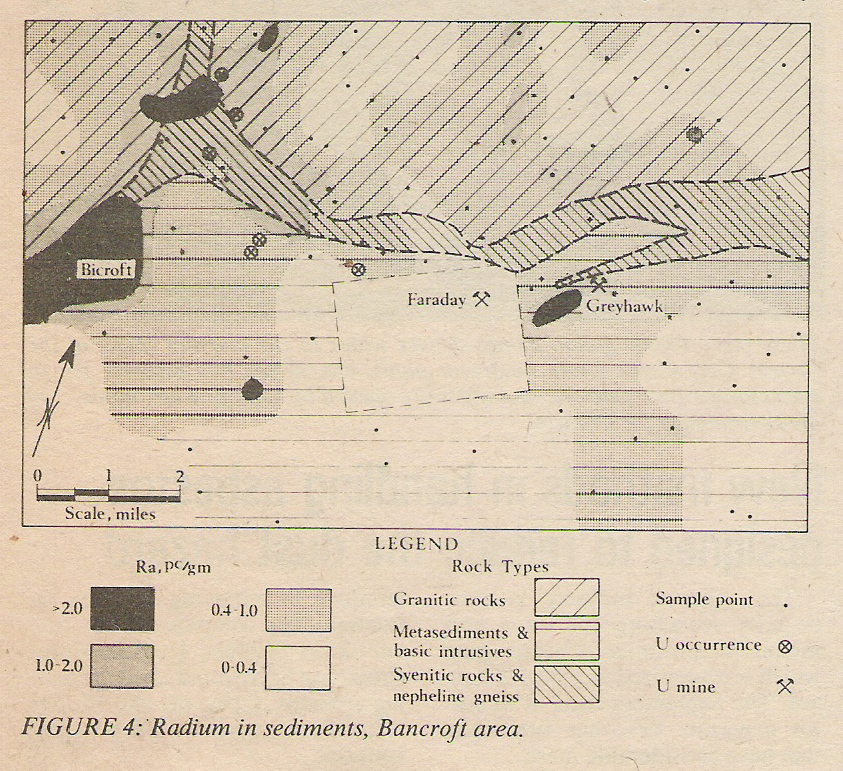Radium Geochemistry in Sediments Responds to Uranium Mineralization at Bancroft

- 95 sediment samples from streams and lakes.
- Clastic and organic sediment. 38 locations have both types, clearly separate and distinct.
- When both types present radium is higher in organic type.
- Radium values in the two types rationalized on a curve and plotted and contoured on the same map (shown).
- Uranium mineralization is concentrated along the belt of syenitic rocks and nepheline gneiss which occupies the contact between plutonic rocks to the northwest and metasedimentary to the southeast.
- Note the high values associated with the mineralization and contact
- Samples downstream from Faraday Mine also high but left off the map because possibly contaminated.
- Published in Canadian Mining Journal, May 1969, p. 75-76
- 258 sediment samples.
- See notes above.
- From Ph.D. thesis, Queen's University, 1970

Click here for more on radon in exploration
- You need 20 grams of sample.
- Cover the sample with water, let the radon grow it to equilibrium, and measure radon in the water in the normal way.
- Half-life to reach eqilibrium is 3.8 days.
- Fine sediments collected wet and kept under water might remain in equilibrium.
- In the same way you can also measure radium in plant parts, soil, crushed rock etc.
- No need for crushing or chemical attack.
- We measure: radon - radium - thoron - radon daughters - alpha radiation.
- The Lucas cell is recognized as the most sensitive and reliable method for these elements.
- Our instruments are used around the world in exploration for uranium, oil & gas, groundwater and hydrothermal, and in health physics, earthquake prediction, and evaluation of hydrocarbon and NAPL contamination.
- In the radon business since 1968, our latest major instrument update was 2011.
- Modern, low-power, field-rugged electronics. Some earlier versions still working after 35 years.
- Winter and summer, from the Sahara Desert to the Canadian Shield, our instruments have faced up to severe field conditions.
- Sensitive to geochemical trace levels necessary for radon in lake water and for radon-thoron isotope ratios.
- Can work in a tent without electricity or be carried from point to point in the field.
- 50 readings per day. Results available immediately.
- Rechargeable battery pack good for a long day in the field and recharges in a few hours.
- Can be operated by junior personnel if carefully supervised.
- Same instruments used for radon and radium in soil, sediment, plant parts, rocks, water, soil gas, air, and snow, and for radon daughters in air.
- Click here for pictures of instruments.
- Click here for or other instruments, components and assessories we provide
-
For instruments contact
R.H. Morse & Associates Ltd.
1-416-269-9979
morse@finderschoice.com
skype: robert.morse.toronto - Multilingual consulting and training (if required).
Robert H. Morse, Ph.D., P.Eng. June 29, 2007